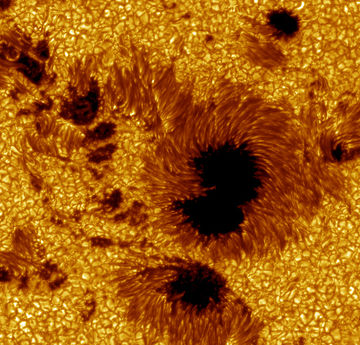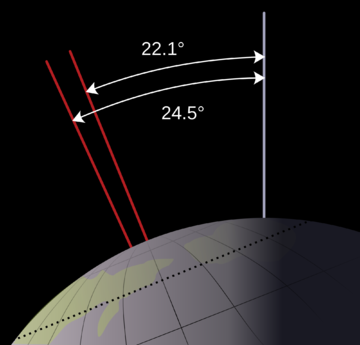External forcing

An external forcing is a type of climate forcing agent that impacts the climate system while being outside of the climate system itself. External forcings include galactic variations, orbital variations, and solar variations - such as sunspots, shown in Figure 1.[2] These external forcing mechanisms can happen on relatively small time scales - around 10 years - up to extremely large time scales of 109 years.[3]
Types of External Forcings
It is important to note that some sources report volcanic activity as being an external forcing instead of an internal forcing. However, here volcanic activity will be classified as a type of internal radiative forcing as a result of their presence within the Earth's physical system. Several sources make the same classification of volcanic activity being internal as a result of their location on the Earth. For information on volcanic activity as an internal forcing see here and here.
Solar Variations
Variations in the amount of solar energy being released from the Sun at a given point in time has been considered as an external forcing factor. However, a connection between the cycles of output from the Sun and climate cycles has not been firmly established.
One of the best known solar cycles is the sunspot cycle, which takes place over a period of 11 years.[4] From observations it has been found that at times of numerous sunspots, the value of the solar constant increases and thus solar irradiance increases with it. Changes of the solar irradiance like the ones that occur during sunspot cycles could force climate changes. Although there are measurable changes during this cycle, it is difficult to associate any observed climate change to these variations as the variations themselves are so small.[3] Additionally, in times where sunspot cycles are less intense it appears there is an associated decrease in the Earth's temperature - however this connection is still not proven. Other solar cycles include the change in solar diameter.[3]
Galactic Variations
In addition to the planets orbiting the Sun in the Solar System, the Solar System itself orbits the centre of the galaxy, and this rotation has been noted as a possible source of external forcings. Over the course of a galactic year - 303 million years - there is some level of variation in the composition of the matter that exists in space between the stars.[5] This variation in the makeup of space could influence the amount of solar radiation that hits the Earth. This change in solar radiation levels makes galactic variations a type of possible radiative forcing. However, it is difficult to confirm this variation as a type of external forcing because of the extremely long timescale.[3]
Orbital Variations
There are a number of different changes in the Earth's orbit around the Sun that have been investigated as possible external forcings. The overall theory of astronomical causes of climate variations is known as the Milankovitch theory, and evidence has been found to support the ideas in the theory. There are three major variations - the tilt of the Earth's axis, it's precession, and eccentricity of the Earth's orbit around the Sun.

The tilt of the Earth on its axis of rotation can change between 22° and 24.5° over the course of 41 000 years (with the angle currently at 23.4°).[3] The tilt of the Earth changes how solar radiation is distributed over the Earth's surface. Although the tilt doesn't change how much solar radiation hits the Earth, the amount of solar radiation hitting a certain area differs. A change in tilt has a minimal effect around the equator, but near the poles as the tilt increases so too does the amount of sunlight that hits this area. This increase in temperature at higher latitudes can cause certain climate effects.[7]
Also, the Earth's orbit around the Sun follows an elliptical, not circular path. The strength of the ellipse or the eccentricity of it is another orbital variation.[7] The orbit of the Earth has been found to vary between almost nearly circular (with an eccentricity of 0.005, the closer the value is to 1 the more elliptical the orbit is) to fairly elliptical (with an eccentricity of 0.06).[3] The changes in eccentricity change how much solar radiation hits the top of the atmosphere, with maximum eccentricity solar radiation hitting the Earth can very 30% over the course of the Earth's orbit.
The final variation is the variation of precession of the Earth. Two components of the Earth's orbit precess - the first is an axial precession which causes the Earth to "wobble" around its own axis like a spinning top. The second is an elliptical precession where the orbit of the Earth itself shifts slightly with the point at which the Earth passes closest to the Sun changes. These changes occur over a large time scale - around 22 000 years.[3] Similar to the Earth's tilt, precession doesn't change how much total energy is received by Earth but changes how it is distributed over time.[7]
References
- ↑ NASA Goddard Space Flight Center. (October 18, 2015). Sunspots [Online]. Available: https://www.flickr.com/photos/gsfc/5510488494
- ↑ IPCC, 2012: Glossary of terms. In: Managing the Risks of Extreme Events and Disasters to Advance Climate Change Adaptation [Field, C.B., V. Barros, T.F. Stocker, D. Qin, D.J. Dokken, K.L. Ebi, M.D. Mastrandrea, K.J. Mach, G.-K. Plattner, S.K. Allen, M. Tignor, and P.M. Midgley (eds.)]. A Special Report of Working Groups I and II of the Intergovernmental Panel on Climate Change (IPCC). Cambridge University Press, Cambridge, UK, and New York, NY, USA, pp. 555-564.
- ↑ 3.0 3.1 3.2 3.3 3.4 3.5 3.6 Global Climate Change. (November 2, 2015). External Forcing Mechanisms" [Online]. Available: http://www.global-climate-change.org.uk/2-5-1.php
- ↑ Nasa Solar Science. (November 7, 2015). Sunspot Cycle [Online]. Available: http://solarscience.msfc.nasa.gov/SunspotCycle.shtml
- ↑ Camel Climate Change. (November 7, 2015). Galactic Variations [Online]. Available: http://www.camelclimatechange.org/topics/view/51cbfc8ef702fc2ba812d48d/
- ↑ Wikimedia Commons. (November 7, 2015). Earth Obliquity Range [Online]. Available: https://upload.wikimedia.org/wikipedia/commons/thumb/a/ae/Earth_obliquity_range.svg/2000px-Earth_obliquity_range.svg.png
- ↑ 7.0 7.1 7.2 NOAA Paleoclimatology. (November 7, 2015). Solar Variations [Online]. Available: http://www.ncdc.noaa.gov/paleo/milankovitch.html

